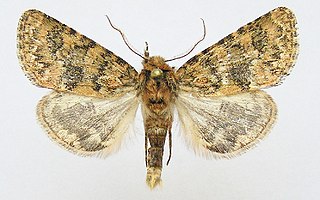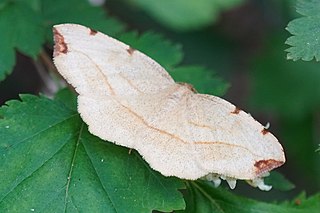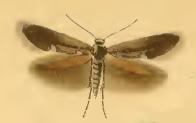
Nyctemera is a genus of tiger moths in the family Erebidae first described by Jacob Hübner in 1820. The genus includes the species Nyctemera annulata and Nyctemera amica, which are closely related and are able to interbreed.

Nepenthes gracilis, or the slender pitcher-plant, is a common lowland pitcher plant that is widespread in the Sunda region. It has been recorded from Borneo, Cambodia, Peninsular Malaysia, Singapore, Sulawesi, Sumatra, and Thailand. The species has a wide altitudinal distribution of 0 to 1100 m above sea level, although most populations are found below 100 m and plants are rare above 1000 m. Despite being a widespread plant, natural hybrids between N. gracilis and other species are quite rare.

Coleophora is a very large genus of moths of the family Coleophoridae. It contains some 1,350 described species. The genus is represented on all continents, but the majority are found in the Nearctic and Palaearctic regions. Many authors have tried splitting the genus into numerous smaller ones, but most of these have not become widely accepted.

Polygonia is a genus of butterflies with a conspicuous white mark on the underside of each hindwing, hence the common name comma. They also have conspicuous angular notches on the outer edges of their forewings, hence the other common name anglewing butterflies. The related genus Nymphalis also includes some anglewing species; Polygonia is sometimes classified as a subgenus of Nymphalis.
Agathiphaga is a genus of moths, known as kauri moths. and is the only living genus in the family Agathiphagidae. This caddisfly-like lineage of primitive moths was first reported by Lionel Jack Dumbleton in 1952, as a new genus of Micropterigidae.

Carnivoramorpha is a clade of placental mammals of clade Pan-Carnivora from mirorder Ferae, that includes the modern order Carnivora and its extinct stem-relatives.

The little grey greenbul is a species of the bulbul family of passerine birds. It is widely distributed across the African tropical rainforest. Its natural habitats are subtropical or tropical moist lowland forests and subtropical or tropical swamps.

Victrix is a genus of moths in the family Noctuidae described by Otto Staudinger in 1879. It may be synonymous with the genus Moureia.
Mursa is a genus of moths of the family Erebidae.

Scoparia is a grass moth genus of subfamily Scopariinae. Some authors have assigned the synonymous taxon Sineudonia to the snout moth family (Pyralidae), where all grass moths were once also included, but this seems to be in error.

Athaumasta is a genus of moths of the family Noctuidae. The genus was erected by George Hampson in 1906.
Copitarsia is a genus of moths of the family Noctuidae. The genus was erected by George Hampson in 1906.
Pararothia is a genus of moths of the family Noctuidae. The genus was erected by Sergius G. Kiriakoff in 1974.

Spilopera is a genus of moths in the family Geometridae.
Carodista is a genus of moths in the family Lecithoceridae. The genus was erected by Edward Meyrick in 1925.
Praepapilio is an extinct genus of swallowtail butterfly from the middle Eocene deposits of Colorado, United States, comparable to the Lutetian epoch in age. The genus is considered to be the only representative of the fossil subfamily Praepapilioninae.
Norapella is a genus of moths in the family Megalopygidae.

Heliozela is genus of moths of the family Heliozelidae, described by Gottlieb August Wilhelm Herrich-Schäffer in 1853.
Exaeretia gracilis is a moth in the family Depressariidae. It was described by Lord Walsingham in 1889. It is found in North America, where it has been recorded from North Dakota to Texas and in California, Colorado, Minnesota, Oklahoma, Wisconsin and Iowa.
Gracilanja is a monotypic moth genus in the family Eupterotidae erected by Thierry Bouyer in 2011. Its single species, Gracilanja gracilis, was described by Francis Walker in 1855. It is found in Cameroon, the Republic of the Congo, the Democratic Republic of the Congo, Equatorial Guinea, Ghana, Sierra Leone and Uganda.









